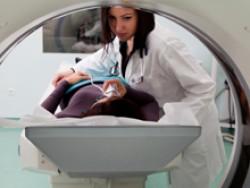Nanocomplexes Label Cells for MRI Tracking
Nanocomplexes Label Cells for MRI Tracking
Nanocomplexes can be used to label transplanted cells so they can be tracked by MRI, according to a new study. In the future, the technique might be used to monitor whether transplanted immune or stem cells reach their targets.

Cell-based therapies have become a major focus in regenerative medicine and tumor treatment. Researchers currently track whether cells reach their destinations using radioisotopes or by implanting a “reporter” gene. But these methods have limitations, including the short half-life of isotopes, dangers in modifying the cell genome and other complications.
A research team led by Dr. Joseph A. Frank of NIH’s Clinical Center and National Institute of Biomedical Imaging and Bioengineering (NIBIB) sought to develop an alternative method of tracking cells using MRI. MRI, or magnetic resonance imaging, uses a large magnet and radio waves to look inside your body. MRI scanners create a magnetic field that locks hydrogen atoms in the body’s water-filled tissues into an aligned magnetic state. When a radio wave is applied, it knocks the hydrogen atoms out of alignment. The atoms in different tissues realign at different rates, producing radiofrequency signals that a computer converts into an image.
Compounds called contrast agents (typically metal complexes) alter the magnetic fields around them, thus affecting radiofrequency signals and creating contrast in MRI images. In recent years, researchers had developed ways to label cells for tracking by MRI. They found success using superparamagnetic iron oxide nanoparticles (SPIONs). However, the SPIONs used in previous studies were later removed from the market.
Ferumoxytol is a SPION recently approved by the U.S. Food and Drug Administration to treat iron-deficiency anemia in chronic kidney disease. Frank and his team set out to explore the use of ferumoxytol as a cell contrast agent. Their investigation appeared in the March 2012 issue ofNature Medicine.
The researchers discovered that they could form nanocomplexes with ferumoxytol by combining it with 2 other drugs: heparin and protamine. When incubated with transplant cells, the nanocomplexes were incorporated into the cells. The scientists detected no ill effects in several different types of cells that they tested. When implanted into rat brains, the labeled cells could be detected via MRI.
This technique uses concentrations of each drug that are well below recommended clinical doses. The nanocomplexes also biodegrade safely. The technology, pending regulatory review, will first be tested in humans in an upcoming trial (NCT01172964). The study will test genetically engineered neural stem cells transplanted into patients with a type of brain tumor.
“Less than 3% of intravenous transplanted cells get to their target. This brings up questions of cell dose, multiple doses, and dose timing and how to make cell therapy approaches more effective,” Frank says. By using MRI to track how cells travel or home in to a desired site, researchers will be able to compare dosage amounts and frequency for the most effective treatments.
###
* The above story is reprinted from materials provided by National Institutes of Health (NIH)
** The National Institutes of Health (NIH) , a part of the U.S. Department of Health and Human Services, is the nation’s medical research agency—making important discoveries that improve health and save lives. The National Institutes of Health is made up of 27 different components called Institutes and Centers. Each has its own specific research agenda. All but three of these components receive their funding directly from Congress, and administrate their own budgets.




















